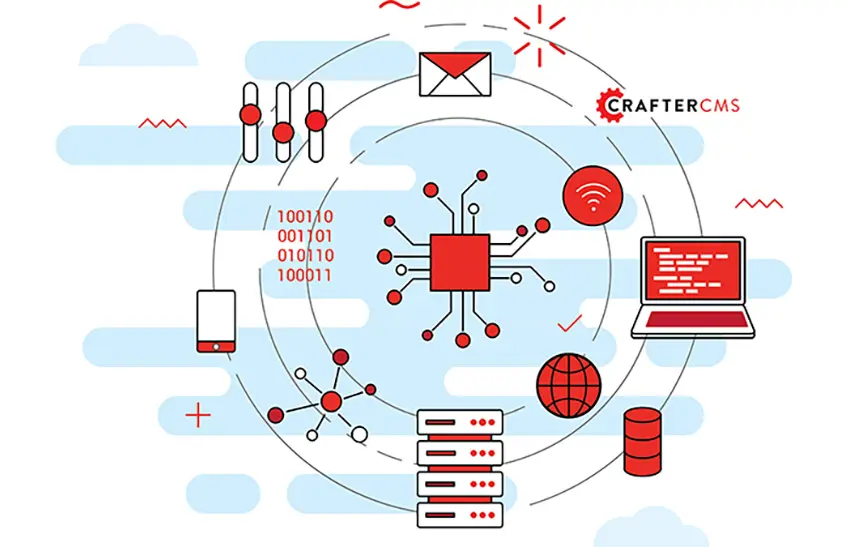The Fundamentals of Digital Innovation: Moving Beyond Digital Transformation

Mike Vertal

Most companies are at some stage in their digital transformation, whether it’s upgrading their legacy infrastructure or modernizing their digital processes and tools. In fact, IDC found that 85% of enterprise decision-makers believe they will fall behind the competition if they don’t make significant progress along their digital transformation journey.
Leveraging modern technologies, while a significant step in the right direction, does not necessarily mean your organization is ready for digital innovation. And innovation is crucial in a rapidly changing digital landscape. In fact, management guru Peter Drucker considered marketing and innovation as the only two areas of business that produced profits… nearly everything else is a cost. That’s why companies need to move beyond digital transformation and think about digital innovation.
In this post, we'll take a closer look at the principles of innovation with a particular focus on digital, why current attempts at digital transformation are not enough, and how your organization can achieve true digital innovation.
Principles of Digital Innovation
When it comes to digital innovation, there are factors to consider for all stakeholders, from end-users to developers, marketers, and IT operations staff.
Marketer Enablement
The key to remaining competitive in the future is a focus on customer experiences. In order to deliver innovative digital experiences, however, companies need to empower marketers. Marketers are producing content at a breakneck pace, and they need intuitive tools to manage and publish this information in a way that drives engagement and maximizes ROI. They also need capabilities like data-driven personalization, omni-channel content delivery, and many more features to craft compelling customer experiences.
Developer Freedom
Your organization can’t innovate if software developers are stuck using outdated technologies. Many traditional and even some modern CMS solutions, for example, dictate the languages, frameworks, technologies and fixed APIs that developers can use, reducing productivity and stifling innovation. The modern CMS needs to support all types of frontend technologies as well as server-side development and extensible APIs, or companies will struggle to rapidly build new features, adopt emerging devices and reach new customer touchpoints. Furthermore, limiting DevOps processes will slow development cycles and drastically prolong the time to market for new features or functionality.
Scalability & Elasticity
Technological innovation means developing and implementing a modern tech stack that can scale to meet future traffic demands. As more devices come online — and more users interact with brands through them — there will be more pressure to deliver high-performance digital experiences across multiple channels. This means companies need to look towards modern approaches to scalability and elasticity like cloud-native architectures, microservices, containerization and orchestration, and stateless, serverless applications. It’s too difficult to innovate with software solutions that have bloated and monolithic architectures.
Innovating with Digital Experiences
When it comes to innovating with digital experiences, there are two main areas we see as critical in the near future: transforming existing experiences and leverage emerging technologies to build new ones.
Transforming Existing Experiences
Along with new platforms and technologies, customer expectations for existing experiences evolve over time. Websites and mobile apps, for example, have been around for a while, but the demand for personalized content and modern digital experiences through these touchpoints has increased in recent years. Companies poised for digital innovation are able to capitalize on this shift in customer expectations using the latest technologies such as single-page apps (SPAs) and progressive web apps (PWAs). They’ve also turned to AI and machine learning to leverage vast amounts of data to deliver personalized customer experiences.
Leveraging Emerging Technologies to Build New Experiences
While digital transformation may have been sufficient to meet the needs of traditional digital channels, there are now emerging technologies like AR/VR, chatbots and digital assistants, and IoT that innovative companies can leverage to get ahead of the competition. Many companies haven’t even considered these touchpoints yet, but digitally innovative companies certainly are. Beyond what’s on the horizon, there are also apps and devices we can’t predict will gain popularity, so that’s why it’s vital to prioritize innovation within your organization.
Moving Beyond Digital Transformation
Digital transformation can bring enormous benefits to your organization in the near-term, but if you don’t look towards the future you will lack agility. If you don’t consider the right modern tech stack, you won’t be poised to take advantage of new or emerging technologies in the long run. That’s why you should go beyond digital transformation, and look to build an agile tech stack.
Open source software will enable your organization to customize and extend your tech stack to meet specific business requirements in the future. Furthermore, using open source and open standards will make it easier to replace systems that no longer meet your organization’s needs with minimal hassle. You want to avoid vendor lock-in. Unfortunately, most organizations fail to choose technologies that are open and adaptable.
Flexibility means the ability to support and integrate with a wide variety of applications and software. Systems are increasingly becoming interconnected, so sharing data and functionality is a necessity. Digital transformation has led many organizations to headless CMS solutions, but these solutions still limit developers to vendor-specific APIs and lack the ability to integrate with modern DevOps practices.
To put it simply, if you’re still in the digital transformation stage, you need to start considering how your tech stack will enable digital innovation when you get there. The tech stack you adopt through innovation should lay the foundation for the future. That means the software companies choose should be flexible and adaptable. If you don’t plan ahead, you’re risking digital stagnation.
What Digital Innovation Looks Like
If you’re looking for an example of digital innovation, look no further than the ambitious Marriott digital strategy.
Using innovative technologies, not just legacy platforms and APIs, the hospitality giant Marriott has successfully rolled out a global extranet that improves internal operations focused on an outstanding customer experience.
The company wanted a centralized content management solution that could work closely with its independent global business units. Marriott needed to provide targeted content for hundreds of different brands across the globe, with intuitive and attractive digital experiences in-line with modern expectations. At the same time, Marriott wanted to reduce its total cost of ownership and improve ROI.
Using CrafterCMS, the hotel chain upgraded to modern web standards and built a better digital experience. Marriott’s distributed content authors are empowered with rich content editing features, while the company’s centralized content managers have a global dashboard for managing complex workflows and publishing schedules, and over 700,000 company associates have the most relevant content at their fingertips to deliver exceptional customer experiences every day.
Read Now: Exploring Marriott’s Content-driven Extranet
But Marriott didn’t stop there.
They continued to innovate using CrafterCMS, building improved digital experiences on marriott.com, creating brand new AR/VR experiences in hotel lobbies, and launching live video streaming applications.
Read Now: How Marriott Livestreams Video Content Around the World
The Tools You Need for Digital Innovation
When it comes to true digital innovation, it means looking beyond your current tech stack and thinking about how you can leverage technologies that are only just emerging. That means having digital processes in-place that enable agility
At Crafter, we believe there are a number of digital processes most companies should adopt to move beyond digital transformation into the digital innovation stage.
Headless+ CMS Solutions
API-first, headless CMS solutions provide a useful first step toward building innovative, multi-channel digital experiences. But as discussed above, marketers and other business users need powerful and easy to use content creation, authoring, and editing tools to fully deliver engaging experiences to their audience. Companies need to move beyond simple headless towards headless+ CMS solutions that provide a) comprehensive WYSIWYG content authoring tools, b) decoupled architectures that are scalable, secure, and higher performance, c) a distributed Git-based repositories for code, configuration AND content, d) complete developer platform with a wide range of extensible APIs (REST, GraphQL, Javascript, in-process, etc.), e) support for both client-side and server-side rendering and back-end integration, customization and API development, f) deployment flexibility including self-managed private cloud, hybrid cloud, and fully managed SaaS, and g) DevOps process and tooling support. All of this is crucial as enterprises look to innovate faster across a variety of digital channels.
DevContentOps Processes
Integrating DevOps processes and tooling into the software development and delivery of content-rich, digital experience applications is a must. A critical part utilizing an Agile methodology means adopting a continuous integration and continuous delivery (CI/CD) approach to the software you build and implement. Extending CI/CD to the content apps is crucially important as well. However, innovative enterprises must look to also break down the barriers between content teams and DevOps teams. They look to implement what we call DevContentOps.
DevContentOps is a methodology that seeks to unite developers, content creators, and operations. It dramatically improves collaboration among software development teams, content teams, and ops teams through a set of methods and tool capabilities (including distributed Git-based repositories), allowing the entire enterprise to focus on achieving the business results that innovation fosters.
Look to Move Beyond Digital Transformation with Digital Innovation
We believe integrating these capabilities into your development processes and tech stack will enable your organization to lead with innovation and stay ahead of the competition. Don’t stop at your digital transformation efforts. Following the principles that drive innovation and you’ll see enormous benefits in the long run.
To learn more, visit our White Paper Library where we have many resources covering the topics of headless, Git, and DevContentOps in more detail.
Related Posts

Websites Are Dead?

Mike Vertal

No-Code Experience Building for Marketers & Designers

Amanda Lee

The Future of Web Experiences: From Browsing and Searching to Conversational AI

Mike Vertal

Is Your CMS MACH-Ready? A Practical Guide for Enterprise Architects

Sara Williams
Related Resources
-

CrafterCMS at eBay: The Universal Content Platform for eBay.com
Webcast
-

Personalized Digital Experiences for a Cruise Liner
Webcast
-

Introducing CrafterCMS v4.0
Webcast
-

Modernizing Video Delivery and Content Management at CPAC, A Canadian Nationwide Broadcaster
Webcast
-

Building React Apps on a Headless CMS
White Paper





